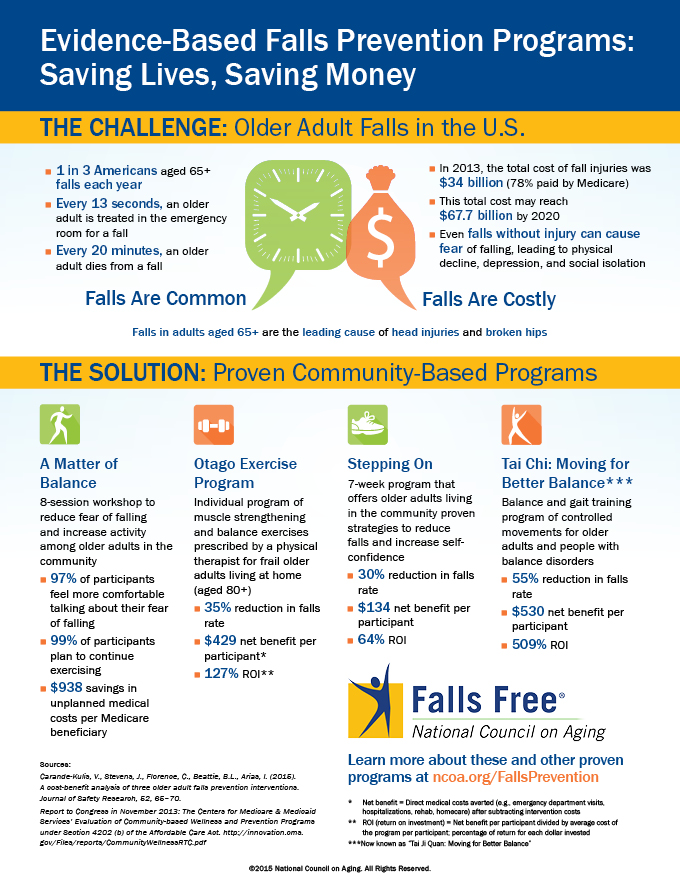In our culture it's been okay to laugh at falls. During Gerald Ford's presidency Time magazine, CBS news, and other mainstream media outlets often presented stories on the President's "clumsiness" as lighthearted news. In 2006, the month Ford died, correspondent Bob Schieffer felt compelled to recount that history writing:
"...after he [Ford] took a tumble or two on the ski slopes and then slipped one rainy day and fell headlong down the stairs coming off Air Force One, he developed the reputation for clumsiness. The joke was Vice President Rockefeller was just a banana peel away from the presidency."
Given the laughter that famous falls have generated it's no wonder they aren't taken seriously or that fall prevention measures are only introduced after a fall occurs---if then. Yet, one in three people 65 or older will fall and, after 70, even a ground level fall can be dangerous or deadly. That's why President Obama launched the STEADI (Stopping Elderly Accidents Deaths & Injuries) initiative this year authorizing grants to increase fall prevention awareness in the public and among health care professionals. Do you know how to prevent a fall? You'll find an abundance of free resources this month through two events: the 8th Annual Falls Prevention Awareness Day on September 23 and Go4Life all September. I learned something new maybe you will too!
We never expect to fall. It's usually a surprise. When we do fall we sometimes regard it as a freak accident we had no control over but fall prevention does help. Learning how to integrate fall prevention measures is important because falls are the leading cause of injury and death after the age of 65. What is fall prevention? Most of us think about home safety measures such as picking up throw rugs, bundling computer wires and cords, installing night lights or handrails and so forth. Fall prevention also includes: getting periodic vision checks and medication reviews and making sure all four aspects of exercise are in your life: strength, flexibility, endurance, and balance.
Falls in later years are hard to heal. Add to that the fact that falling once doubles the chance that you will fall again. With fall prevention knowledge we can improve both chances of recovery and the probability that we won't fall. Exercise is a good place to start. Go4Life, a month long campaign to lift awareness of the need for all four aspects of exercise, offers a free book, free DVD, and online video guides. Try the free balance exercises. You may discover room for improvement! Watch their online strength building videos. Find an exercise you can add to your life?
 If Go4Life resources aren't spurring you to action consider enrolling in a falls prevention program in your community. Local senior centers usually offer Tai Chi classes. Tai Chi is a gentle exercise that cultivates confidence, flexibility and good balance. Tai Chi and other certified programs such as; Enhance Fitness and A Matter of Balance offer evidence based value in preventing falls. Check their websites for upcoming programs and locations. Can't find a program locally? Otago program exercises are on you tube as are many other programs geared toward older adults. Are you self motivated enough to follow the sessions at home? If so, check it out!
If Go4Life resources aren't spurring you to action consider enrolling in a falls prevention program in your community. Local senior centers usually offer Tai Chi classes. Tai Chi is a gentle exercise that cultivates confidence, flexibility and good balance. Tai Chi and other certified programs such as; Enhance Fitness and A Matter of Balance offer evidence based value in preventing falls. Check their websites for upcoming programs and locations. Can't find a program locally? Otago program exercises are on you tube as are many other programs geared toward older adults. Are you self motivated enough to follow the sessions at home? If so, check it out!
The Annual Fall Prevention Awareness Day is September 23rd. Falls can happen suddenly and be deadly yet we have many tools available to help us prepare for and prevent falls. Let's spread the word this month that falls are a threat as we age yet fall prevention programs work and they can be lots of fun. If you attend local organizations such as senior centers consider talking about developing a fall prevention program.
Stay safe, dear reader. Don't let a fall happen to you or your loved ones. Engage in active prevention. Take advantage of free fall prevention resources and bring fall prevention awareness into your life and that of your community.

